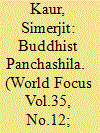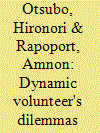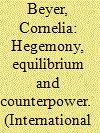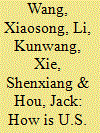|
|
|
Sort Order |
|
|
|
Items / Page
|
|
|
|
|
|
|
| Srl | Item |
| 1 |
ID:
130166


|
|
|
|
|
| Publication |
2014.
|
| Summary/Abstract |
Ever since the dawn of civilization the human beings have the tendency to live in a group, called society, which is generally made up of the people carrying diverse and divergent views and outlooks relating to different aspects of life. To maintain balance in the atmosphere of diverse views and outlooks of the people society requires some sorts of balancing force akin to lever, which plays an important role in maintaining the balance between two forces, weights, etc of a machine or instrument. Buddhism keeping in view the different aspects of human life, prescribed different modes of path or way of life to establish peaceful and equanimous society. Pañcas?la is one of them, the practice of which is important for the smooth functioning of life and also to have social equilibrium.
|
|
|
|
|
|
|
|
|
|
|
|
|
|
|
|
| 2 |
ID:
121729


|
|
|
|
|
| Publication |
2013.
|
| Summary/Abstract |
Premodern Sino-Vietnamese relations may be described by three systems of engagement that I have labeled Strong China/Weak Vietnam, Weak China/Strong Vietnam, and Strong China/Strong Vietnam. These three states of interaction appear at various points, beginning with Vietnamese encounters with the Qin empire (221- 206 b.c.e.) through the early modern era. Brantly Womack has already described the historical Sino-Vietnamese relationship as politically "asymmetrical" with China playing the strongman role, and the three relational equilibriums described here do not contradict Womack's thesis. Instead, I explore how the generally asymmetrical states of affairs were molded by historical context and the specific ambitions of elite in the frontier region. While the general conditions of the Sino-Vietnamese relationship were asymmetrical, the choices available to Chinese and Vietnamese leaders in different periods varied widely.
|
|
|
|
|
|
|
|
|
|
|
|
|
|
|
|
| 3 |
ID:
084032


|
|
|
|
|
| Publication |
2008.
|
| Summary/Abstract |
Volunteer's dilemmas that evolve over time are presented and modeled as noncooperative n-person games in extensive form with symmetric players, discrete time, finite horizon, and complete information. Volunteering is costly, thereby giving rise to free riding. Reflecting on the observation that in many naturally occurring social dilemmas it is beneficial to volunteer earlier than later, the model assumes that the payoff to the volunteer and the (higher) payoff to each of the nonvolunteers decrease monotonically over time. The authors construct symmetric and asymmetric subgame perfect equilibria to the game. An experimental study shows that financially motivated subjects who are rewarded contingent on their performance volunteer more readily when the cost of volunteering is relatively low; that they largely fail to coordinate on any of the asymmetric equilibria in which only a single subject volunteers immediately; that they volunteer, on average, earlier than predicted; and that they vary considerably from one another in their inclination to free ride.
|
|
|
|
|
|
|
|
|
|
|
|
|
|
|
|
| 4 |
ID:
108045


|
|
|
|
|
| Publication |
2011.
|
| Summary/Abstract |
The 2010 Strategic Concept reaches an equilibrium among different Allies' views by rejecting extreme options, combining 'regional' and 'global' elements in a new common ground, and setting up flexible guidelines for NATO's future evolution. It is the result of 20 years of transatlantic debate over NATO's role and geographic reach, and represents a significant step forward with respect to the previous Strategic Concept approved in 1999.
|
|
|
|
|
|
|
|
|
|
|
|
|
|
|
|
| 5 |
ID:
092038


|
|
|
|
|
| Publication |
2009.
|
| Summary/Abstract |
This article claims that realist and constructivist ideas are compatible. Structural realism is needed to understand the constraining and stabilizing role of material factors. Furthermore, it detects process in a law-like tendency towards international power equilibrium which is achieved via balancing. Constructivism, in turn, highlights the importance of ideas and norms as engines for change and the creative role of agency. The article therefore combines a materialist and an idealist perspective. It both detects elements of stability and argues for necessary improvements in current international relations (IR) by looking at the issues of United States hegemony, the rise of new challengers and the threat of sub-state international terrorism. This article, therefore, takes up important claims made by Kenneth Waltz on realism, hegemony and terrorism, and interprets them in the light of IR theory today. It is argued that structural realism and Waltz's ideas are still important and viable, but that we need to combine them with additional perspectives, notably constructivism.
|
|
|
|
|
|
|
|
|
|
|
|
|
|
|
|
| 6 |
ID:
124542


|
|
|
|
|
| Publication |
2013.
|
| Summary/Abstract |
Utilizing a political economy approach towards trade policy formulation, we examine the case of how the U.S. House voted on the PNTR status for China. Our focus is to analyze the factors affecting the legislators' voting behavior and to deduce the rationale behind these factors. We find that the U.S. trade policies towards China represent a balanced equilibrium based on interactions between the government and special interest groups. The individual characteristics of the legislators were not important in the process. Predictions of neo-classical trade models regarding the attitudes of various groups on trade liberalization could not be fully validated in the voting outcome of the PNTR bill.
|
|
|
|
|
|
|
|
|
|
|
|
|
|
|
|
| 7 |
ID:
104479


|
|
|
| 8 |
ID:
095379


|
|
|
|
|
| Publication |
2010.
|
| Summary/Abstract |
The crisis bargaining literature sees demands as endogenous to crises. However, despite the parallels between military and economic coercion, sanctions researchers have preferred to analyze economic coercion after demands have been issued, and have not explored sufficiently the possibility that when senders formulate their policy objectives, they consider the international constraints imposed by the capabilities and interests of target states. I complement the sanctions literature by deriving the implications of strategic goal formulation in a game theoretic model of economic coercion that assumes endogenous demands. The model explains the inconsistent empirical relationship between sanctions costs and outcomes as well as the paradoxical tendency of senders to select into difficult disputes. I find that threats are not always more effective than sanctions and suggest what an optimal sanctions policy might look like.
|
|
|
|
|
|
|
|
|
|
|
|
|
|
|
|
| 9 |
ID:
069890


|
|
|
|
|
| Publication |
2005.
|
| Summary/Abstract |
The pattern of cooperative behavior seen in the Concert of Europe during the first half of the nineteenth century resulted from a commitment to uphold the settlement, which hinged on the credibility of enforcement threats and a distribution of benefits commensurate with military capabilities. The equilibrium was self-enforcing because the powers that could oppose an alteration of the system had incentives to do so, and the powers that could upset it did not have incentives to do so. This behavior is markedly different from eighteenth-century practices, although no change in state preferences is necessary to explain the change in behavior
|
|
|
|
|
|
|
|
|
|
|
|
|
|
|
|
|
|
|
|
|